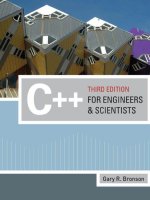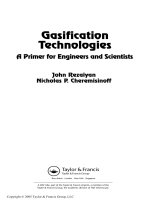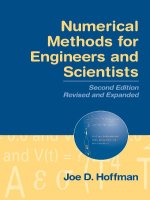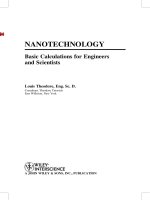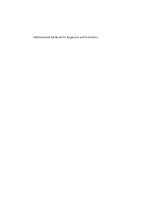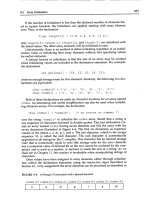- Trang chủ >>
- Khoa Học Tự Nhiên >>
- Vật lý
nanotechnology. basic calculations for engineers and scientists, 2006, p.481
Bạn đang xem bản rút gọn của tài liệu. Xem và tải ngay bản đầy đủ của tài liệu tại đây (2.38 MB, 481 trang )
NANOTECHNOLOGY
Basic Calculations for Engineers
and Scientists
Louis Theodore, Eng. Sc. D.
Consultant, Theodore Tutorials
East Williston, New York
A JOHN WILEY & SONS, INC., PUBLICATION
NANOTECHNOLOGY
NANOTECHNOLOGY
Basic Calculations for Engineers
and Scientists
Louis Theodore, Eng. Sc. D.
Consultant, Theodore Tutorials
East Williston, New York
A JOHN WILEY & SONS, INC., PUBLICATION
Copyright # 2006 by John Wiley & Sons, Inc. All rights reserved
Published by John WIley & Sons, Inc., Hoboken, New Jersey
Published simulataneously in Canada
Not part of this publication may be reproduced, stored in a retrieval system, or transmitted in any form or
by any means, electronic, mechanical, photocopying, recording, scanning, or otherwise, except as
permitted under Section 107 or 108 of the 1976 United States Copyright Act, without either the prior
written permission of the Publisher, or authorization through payment of the appropriate per-copy fee to
the Copyright Clearance Center, Inc., 222 Rosewood Drive, Danvers, MA 01923, (978) 750-8400, fax
(978) 750-4470, or on the web at www.copyright.com. Requests to the Publisher for permission should be
addressed to the Permission Department, John Wiley & Sons, Inc., 111 River Street, Hoboken, NJ 07030,
(201) 748-6011, fax (201) 748-6008, or online at />Limit of Liability/Disclaimer of Warranty: While the publisher and author have used their best efforts in
preparing this book, they make no representations or warranties with respect to the accuracy or
completeness of the contents of this book and specifically disclaim any implied warranties of
merchantability or fitness for a particular purpose. No warranty may be created or extended by sales
representatives or written sales materials. The advice and strategies contained herein may not be suitable
for your situation. You should consult with a professional where appropriate. Neither the publisher nor
author shall be liable for any loss of profit or any other commercial damages, including but not limited to
special, incidental, consequential, or other damages.
For general information on our other products and services or for technical support, please contact our
Customer Care Department within the United States at (800) 762-2974, outside the United States at (317)
572-3993 or fax (317) 572-4002.
Wiley also publishes its books in a variety of electronic formats. Some content that appears in print may
Library of Congress Cataloging-in-Publication Data:
Theodore, Louis.
Nanotechnology: basic calculations for engineers and scientists / Louis Theodore.
p. cm.
“Wiley-Interscience.”
Includes bibliographical references and index.
ISBN-13: 978-0-471-73951-7
ISBN-10: 0-471-73951-0
1. Nanotechnology Mathematics Problems, exercises, etc. I. Title.
T174.7.T477 2006
620
0
.5 dc22
2005047794
Printed in the United States of America
10987654321
not be available in electronic formats. For more information about Wiley products, visit our web site at
www.wiley.com.
Nature is neutral. Man has wrestled from nature the power to make the world a
desert or to make the deserts bloom. There is no evil in the atom; only in men’s
souls.
—Adlai Stevenson, 1952
Ill can he rule the great, that cannot reach the small.
—Edmund Spenser, 1596
The small and tiny shall become all-powerful
—L. Theodore, 2006
Contents
Preface xvii
Introduction xix
PART 1: CHEMISTRY FUNDAMENTALS AND PRINCIPLES 1
1 Units, Conversion Constants, and Dimensional Analysis 3
1.1 Background on the Metric System 4
1.2 Describe the SI System of Units 6
1.2.1 Seven Base Units 7
1.2.2 Two Supplementary Units 8
1.2.3 SI Multiples and Prefixes 8
1.3 The Conversion Constant g
c
9
1.4 Unit Conversion Factors: General Approach 10
1.5 Temperature Conversions 11
1.6 Pressure Calculations 11
1.7 Density and Thermal Conductivity 13
1.8 Viscosity Conversions 14
1.9 Air Quality Standard 14
1.10 Conversion Factors for Particulate Measurements 15
1.11 Significant Figures and Scientific Notation 15
1.12 Uncertainty in Measurement 17
2 Atoms, Elements, and the Periodic Table 19
2.1 Atomic Theory 21
2.2 The Avogadro Number 21
2.3 Mass and Size of Atoms 22
2.4 Atomic Conversions 23
2.5 Atomic Number, Atomic Weight, and Mass Number 24
2.6 Bismuth Application 24
2.7 Elements 24
2.8 Symbols for Elements 27
2.9 Periodic Table Application 28
2.10 Isotopes 29
vii
3 Molecular Rearrangements 31
3.1 License Plate Sets 31
3.2 Chemical Permutations and Combinations 32
3.3 Formula Weight and Molecular Weight 34
3.4 Mole/Molecule Relationship 34
3.5 Pollutant Chemical Formulas 35
3.6 Stoichiometry 36
3.7 Limiting and Excess Reactants 36
3.8 Combustion of Chlorobenzene 37
3.9 Metal Alloy Calculation 39
3.10 Chemical Production 40
4 Concentration Terms 43
4.1 Density, Specific Gravity, and Bulk Density 43
4.2 Classes of Solution 45
4.3 Molality versus Molarity 45
4.4 Molar Relationships 46
4.5 Concentration Conversion 47
4.6 Chlorine Concentration 48
4.7 Trace Concentration 49
4.8 Ash Emission 50
4.9 Dilution Factor 51
4.10 Nano Exhaust to Atmosphere 52
4.11 Flue Gas Analysis 52
4.12 pH 53
5 Particle Size, Surface Area, and Volume 55
5.1 Sphere, Cube, Rectangular Parallelepiped, and Cylinder 56
5.2 Parallelogram, Triangle, and Trapezoid 57
5.3 Polygons 57
5.4 Elipse and Ellipsoid 58
5.5 Cones 58
5.6 Torus 59
5.7 Area to Volume Ratios 59
5.8 Area to Volume Calculation 60
5.9 Increase in Sphere Surface Area 60
5.10 Increase in Cube Surface Area 61
6 Materials Science Principles 63
6.1 Metals, Polymers, and Ceramics 63
6.2 Composites, Semiconductors, and Biomaterials 64
6.3 Crystal Coordination Numbers 64
6.4 Geometry of Metallic Unit Cells 70
6.5 Geometry of Ionic Unit Cells 75
6.6 Packing Factor 78
viii CONTENTS
6.7 Density Calculation 80
6.8 Directions and Planes 83
6.9 Linear Density 88
6.10 Planar Density 90
7 Physical and Chemical Property Estimation 95
7.1 Property Differences 96
7.2 Material Selection 97
7.3 Vapor Pressure 97
7.4 Vapor Pressure Calculation 98
7.5 Heat of Vaporization From Vapor Pressure Data 99
7.6 Critical and Reduced Properties 100
7.7 Estimating Enthalpy of Vaporization 101
7.8 Viscosity 104
7.9 Thermal Conductivity 106
7.10 Thermal Conductivity Application 108
7.11 Nokay Equation and Lydersen’s Method 109
7.12 The Rihani and Doraiswamy Procedure, and the
Lee–Kesler Equation 113
References: Part 1 117
PART 2: PARTICLE TECHNOLOGY 119
8 Nature of Particulates 121
8.1 Definition of Particulates 121
8.2 Dust, Smoke, and Fumes 122
8.3 Mist and Drizzle 123
8.4 Changing Properties 123
8.5 Dust Explosions 123
8.6 Adsorption and Catalytic Activity in the Atmosphere 125
8.7 Particle Size 125
8.8 Particle Volume and Surface Area 126
8.9 Volume/Surface Area Ratios 127
8.10 Particle Formation 128
9 Particle Size Distribution 131
9.1 Representative Sampling 131
9.2 Typical Particle Size Ranges 132
9.3 Particle Size Distribution and Concentration for Industrial
Particulates 132
9.4 Particle Size Distribution 133
9.5 Median and Mean Particle Size 133
CONTENTS ix
9.6 Standard Deviation 136
9.7 The Frequency Distribution Curve 137
9.8 The Cumulative Distribution Curve 138
9.9 The Normal Distribution 139
9.10 The Log Normal Distribution 141
9.11 Effect of Size Distribution on Cumulative Distribution Plots 143
9.12 Nanoparticle Size Variation With Time 145
10 Particle Sizing and Measurement Methods 151
10.1 Tyler and U.S. Standard Screens 152
10.2 Equivalent Diameter Terms 154
10.3 Aerodynamic Diameter 155
10.4 Sizing Devices 157
10.4.1 Microscopy 157
10.4.2 Optical Counters 158
10.4.3 Electrical Aerosol Analyzer 158
10.4.4 Bahco Microparticle Classifier 158
10.4.5 Impactors 158
10.4.6 Photon Correlation Spectroscopy (PCS) 159
10.5 Rectangular Conduit Sampling 159
10.6 Volumetric Flow Rate Calculation 160
10.7 Particle Mass Flow Rate Calculation 162
10.8 Average Particle Concentration 163
10.9 Equal Annular Areas for Circular Ducts 164
10.10 Traverse Point Location in Circular Ducts 165
10.11 Duct Flow Equation Derivation 166
10.12 Source Characteristics and Variations 168
11 Fluid Particle Dynamics 171
11.1 The Gravitational Force 172
11.2 The Buoyant Force 172
11.3 The Drag Force 174
11.4 The Drag Coefficient 174
11.5 Equation of Particle Motion/Balance of Forces on a Particle 176
11.6 Particle Settling Velocity Equations 177
11.7 Determination of the Flow Regime 178
11.8 Settling Velocity Application 179
11.9 The Cunningham Correction Factor 180
11.10 Cunningham Correction Factor Values for Air at Atmospheric
Pressure 181
11.11 Particle Settling Velocity – Different Regimes 182
11.12 Brownian Motion/Molecular Diffusion 186
x CONTENTS
12 Particle Collection Mechanisms 187
12.1 Gravity 188
12.2 Centrifugal Force 188
12.3 Inertial Impaction and Interception 190
12.4 Electrostatic Effects 192
12.5 Thermophoresis and Diffusiophoresis 193
12.6 Acceleration Effects 194
12.7 Brownian Motion/Molecular Diffusion Effects 194
12.8 Nonspherical Particles 196
12.9 Wall Effects 197
12.10 Multiparticle Effects 198
12.11 Multidimensional Flow 198
12.12 Collection Efficiency for Nanosized/Submicron Particles 199
13 Particle Collection Efficiency 201
13.1 Collection Efficiency: Loading Data 202
13.2 Collection Efficiency: Mass Rate 202
13.3 Efficiency of Multiple Coll ectors 204
13.4 Penetration 204
13.5 Collection Efficiency: Numbers Basis 205
13.6 Particle Size–Collection Efficiency Relationships 206
13.7 Collection Efficiency: Surface Area Basis 207
13.8 Particle Size Distribution/Size–Efficiency Calculation 208
13.9 Check for Emission Standards Compliance: Numbers Basis 210
13.10 Anderson 2000 Sampler 211
References: Part 2 215
PART 3: APPLICATIONS 217
14 Legal Considerations 219
14.1 Intellectual Property Law 219
14.2 Patents 220
14.3 Contract Law 220
14.4 Tort Law 221
14.5 Recent Patent Activity 222
14.6 Conservation Law For Mass 222
14.7 Conservation Law for Energy 224
14.8 The Second Law of Thermodynamics 226
14.9 Allowable Patent Application Claims 228
14.10 Practicing One’s Own Invention 229
CONTENTS xi
15 Size Reduction 231
15.1 Size Reduction Objectives 231
15.2 Plasma-Based and Flame-Hydrolysis Methods 232
15.3 Chemical Vapor Deposition and Electrodeposition 233
15.4 Sol-Gel Processing 233
15.5 Mechanical Crushing 235
15.6 Promising Technologies 235
15.7 Energy and Power Requirements 236
15.8 Potential Dust Explosions With Size Reduction 238
15.9 Material Balance Size Reduction 238
15.10 Size Reduction Surface Area Increase 239
15.11 Fines Eductor Application 241
15.12 Fines Eductor Size Reduction 242
16 Prime Materials 245
16.1 Metals 246
16.2 Iron 246
16.3 Aluminum 247
16.4 Nickel 247
16.5 Silver 248
16.6 Gold 248
16.7 Iron Oxides 248
16.8 Aluminum Oxide 249
16.9 Zirconium Dioxide 249
16.10 Titanium Dioxide 250
16.11 Zinc Oxide 251
16.12 Silica Products 251
17 Production Manufacturing Routes 253
17.1 Carbon Nanotubes and Buckyballs 254
17.2 Semiconductor Manufacturing 255
17.3 Advanced Composites 256
17.4 Advanced Ceramics 258
17.5 Catalytic and Photocatalytic Applications 260
17.6 Gas Sensors and Other Analytical Devices 261
17.7 Consumer Products 262
17.8 Drug Delivery Mechanisms and Medical Therapeutics 262
17.9 Microelectronics Applications 264
17.10 Future Activites 264
18 Ventilation 267
18.1 Indoor Air Quality 268
18.2 Indoor Air/Ambient Air Comparison 269
18.3 Sources of Contaminents in Indoor Air 269
18.4 Industrial Ventilation System 271
xii CONTENTS
18.5 Dilution Ventilation vs. Local Exhaust Sy stems 271
18.6 Ventilation Definitions 273
18.7 Air Exchange Rate 276
18.8 Accidental Emission 278
18.9 Dilution Ventilation Application 279
18.10 Vinyl Chloride Application 280
18.11 Ventilation Models 282
18.12 Minimum Ventilation Flowrate 286
19 Dispersion Considerations 289
19.1 Atmospheric Deposition Calculation 290
19.2 Ground Deposition of Particles 291
19.3 Plume Rise 293
19.4 Pasquill–Gifford Model 294
19.5 Ground-Level Particle Deposition 298
19.6 Line and Area Sources 300
19.7 Instantaneous “Puff” Model 303
19.8 Instantaneous “Puff” Sources 306
19.9 U.S. EPA Dispersion Models 307
19.10 Dispersion in Water Systems and Soils 308
19.11 Canal Concentration Profile 309
19.12 Accidenctal/Emergency Discharge into a Lake/Reservoir 311
20 Ethics 315
20.1 Determination of Ethical Values 315
20.2 Do’s and Don’ts 316
20.3 Codes of Ethics 316
20.4 The Heavy Metal Dilemma 317
Fact Pattern 317
20.5 Let Them Worry About It 319
Fact Pattern 319
20.6 It’s In the Air 321
Fact Pattern 321
20.7 Cheap at What Price 322
Fact Pattern 322
20.8 Safety Comes First 323
Fact Pattern 323
20.9 Intellectual Property 324
Fact Pattern 324
20.10 There’s No Such Thing as a Free Seminar 325
Fact Pattern 325
References: Part 3 327
CONTENTS xiii
PART 4: ENVIRONMENTAL CONCERNS 331
21 Environmental Regulations 333
21.1 The Regulatory System 334
21.2 Air Quality Issues 335
21.3 Particulate Loading 337
21.4 Clean Air Act Acronyms 339
21.5 Water Pollution Control 342
21.5.1 Federal Water Pollution Control Act 342
21.5.2 Safe Drinking Water Act 342
21.5.3 Oil Pollution Control Act 343
21.6 Water Quality Issues 343
21.7 Clean Water Act and PWPs 345
21.8 Wastewater Composition 346
21.9 Solid Waste Management Issues 348
21.10 Hazardous Waste Incinerator 349
21.11 Nanotechnology Environmental Regulations Overview 350
21.12 Nanotechnology Opponents 352
22 Toxicology 353
22.1 The Science of Toxicology 353
22.2 Toxicology Classifications 354
22.3 Routes of Exposure 354
22.4 Threshold Limit Value (TLV) 355
22.5 Toxicology Terminology 356
22.6 TLV vs. PEL 357
22.7 Toxicity Factors 357
22.8 OSHA and NIOSH 358
22.9 Toxicology Determination 359
22.10 IDLH and Lethal Level 359
22.11 Chemical Exposure 361
22.12 Threshold Limit Values 362
23 Noncarcinogens 365
23.1 Hazard Quotient 365
23.2 Reference Dose 366
23.3 Concept of Threshold 367
23.4 Exposure Duration Classification 368
23.5 Risk For Multiple Agents: Chronic Exposure 369
23.6 Risk for Multiple Agents: Subchronic Exposure 370
23.7 Multiple Exposure Pathways 371
23.8 MCL and RfD 372
23.9 Uncertainly and Modifying Factors 372
23.10 Calculating an RfD from NOAEL 373
xiv CONTENTS
23.11 Metal Plating Facility Application 374
23.12 Noncarcinogen Calculation Procedure 374
24 Carcinogens 377
24.1 Nonthreshold Concept 377
24.1 Weight of Evidence and Slope Factor 378
24.3 Carcinogenic Toxicity Values 380
24.4 Benzene in Water Application 381
24.5 Excess Lifetime Cancer Cases 382
24.6 Action Level 382
24.7 Accidental Spill 383
24.8 Uncertainties and Limitations 384
24.9 Multiple Chemical Agents and Exposure Pathways 385
24.10 Exponential Risk Model 386
24.11 Risk Algorithm 386
24.12 Risk Algorithm Application for Benzene 388
25 Health Risk Assessment 391
25.1 Risk Definitions 392
25.2 The Health Risk Evaluation Process 392
25.3 Standand Values for Individuals 394
25.4 Qualitative Risk Scenarios 395
25.5 Example of a Health Risk Assessment 396
25.6 Chemical Exposure in a Laboratory 397
25.7 Laboratory Spill 398
25.8 Respirators 399
25.9 Performance of a Carbon Cartridge Respirator 400
25.10 Sampling Program 402
26 Hazard Risk Assessment 407
26.1 Example of a Hazard 408
26.2 Risk Evaluation Process for Accidents 408
26.3 Plant and Process Safety 411
26.4 Series and Parallel Systems 412
26.5 Binomial Distribution 413
26.6 The Poisson Distribution 414
26.7 The Weibull Distribution 415
26.8 The Normal Distribution 416
26.9 Soil Contamination 419
26.10 Event Tree Analysis 420
26.11 Fault Tree Analysis 421
26.12 Upper and Lower Flamability Limits 425
27 Epidemiology 429
27.1 Historical View 429
CONTENTS xv
27.2 Occupational Health 430
27.3 Descriptive Studies 431
27.4 Probability 432
27.5 Prevalence 432
27.6 Incidence Rate 433
27.7 The Mean 434
27.8 The Variance and the Standard Deviation 435
References: Part 4 437
Appendix Quantum Mechanics 439
Index 447
xvi CONTENTS
Preface
It is not a secret that the teaching of a nanotechnology course will soon be required in
most engineering and science curricula. It is also generally accepted as one of the
key state-of-the-art courses in applied science. The need to develop an understand-
ing of this general subject matter for the practicing engineer and scientist of the
future cannot be questioned.
One of the problems with nanotechnology is that its range of subject matter is so
broad that nearly every engineering and science discipline falls under the nano
umbrella; in effect, it is interdisciplinary. Adding to the confusion is that no
clear-cut definition of nanotechnology has emerged since its infancy nearly a half
century ago. The reader will soon note that the author has not laid claim to an
end-all definition, but rather refers to nanotechnology simply as nanotechnology.
This project was a unique undertaking. Rather than prepare a textbook on nano-
technology, the author considered writing a problem-oriented book because of the
dynamic nature of this emerging field. Ultimately, it was decided to prepare an over-
view of this subject through illustrative examples rather than to provide a compre-
hensive treatise. One of the key features of this book is that it could serve both
academia (students) and industry. Thus, it offers material not only to individuals
with limited technical background, but also to those with extensive industrial experi-
ence. As such, it can be used as a text in either a general engineering or science
course and (perhaps primarily) as a training tool for industry.
As is usually the case in preparing a manuscript, the question of what to include
and what to omit has been particula rly difficult. However, the problems and sol-
utions in this work attempt to address principles and basic calculations common
to nanotechnology.
This basic calculations workbook is an outgrowth of the 2005 John Wiley & Sons
book “Nanotechnology: Environmental Implications and Solutions”. The desirabil-
ity of publishing a workbook that focuses almost exclusively on nanotechnology
calculations was obvious following the completion of that book.
This book contains nearly 300 problems related to a variety of topics of relevan ce
to the nanotechnology field. These p roblems are organized into the following four
Parts or Categories:
Chemistry Fundamentals and Principles
Particle Technology
Applications
Environmental Concerns
xvii
Each Part is divided into a number of problem Sections (or Chapters), with each
set containing anyw here from 8 to 12 problems and solutions. The interrelationship
between the problems is emphasized in all Parts.
The general appro ach employed involved the use of solved illustrative examples.
However, introductory paragraphs are included in each Part and each Section. The
remainder of the text consists of solved examples. In each Part, these have been
chosen to emphasize the most important basic concepts, issues, and applications
that arise in the topic covered by that Part.
Another feature of this work is that the solu tions to the problems are presented in
a stand-alone manner. Throughout the book, the problems are laid out in such a way
as to develop the reader’s technical understanding of the subject in question. Each
problem contains a title, problem statement, data, and solution, with the more diffi-
cult problems located at or near the end of each problem set (Section). Although
some of the topics are somewhat segmented and compartmentalized (relative to
each other), every attempt was made to present and arrange each subject in a
logical order.
The author cannot claim sole authorship to all the problems and material in this
book. The main sources that were employed in preparing the problems include d
numerous Theodore Tutorials (plus those concerned with the professional engineer-
ing exam) and the Reynolds, Jeris and Theodore 2004 Wiley-Interscience text,
“Handbook of Chemical and Environmental Engineering Calculations”. Finally,
the author wishes to acknowledge the National Science Foundation for supporting
several faculty workshops that produced a number of problems appearing in this
work.
The author also wishes to thank Dr. Albert Swertka, Professor Emeritus of
Physicis, U.S. Merchant Marine Academy, for contributing an outstanding write-
up in layman terms on “Quant um Mechanics”. It can be found in the Appendix.
This material was included for those readers interested in obtaining a (better) under-
standing of how quantum mechanics is related to nanotechnology.
Somehow, the editor usually escapes acknowledgement. I was particularly
fortunate to have Bob Esposito (“Espo” to us) of John Wiley & Sons serv e as my
editor. His advice, support, and encouragement is appreciated.
It is the hope of the editor and author that this basic calculations text provides
support in developing an understanding of nanotechnology, and that it will
become a useful resource for the training of engineers and scientists in mastering
this critical topic area.
Louis Theodore
January 2006
xviii PREFACE
Introduction
Technical individuals have traditionally conducted calculation-related studies using
one of a combination of the following approaches (see Figure A):
1. Macroscopic level
2. Microscopic level
3. Molecular level
These studies generally involve the application of a conse rvation law, e.g., mass,
energy, and momentum. For example, if one were interested in determining
changes occuring at the inlet and outlet of a system under study, the conservation
law is applied on a “macrocopic” level to the entire system. The resultant equation
describes the overall changes occuring to the system without regard for internal vari-
ations within the system. This approach is usually employed in a Unit Operations
(for chemical engineers) course. The microscopic approach is employed when
detailed information concerning the behavior within the system is required, and
this is often requested of and by technical personnel. The conservation law is then
applied to a differential element within the system, which is large compared to an
individual molecule, but small compared to the entire system. The resultant equation
is then expanded, via an integration, to describe the behavior of the entire system.
This has come to be defined by some as the transport phenomena approach. The
molecular approach involves the application of the conservation law to individual
molecules. This leads to a study of statistical and quantum mechanics – both of
which are beyond the scope of this text.
Approaches (1) and (2) are normally in the domain of the engineer, while (2) and
(3) are employed by the scientist, particularly the physicist. In a very real sense, this
Figure A Engineering and Science Approaches
xix
text emphasizes (1), since it has been written for the practicing engineer and scien-
tist, and attempts to provide solutions to real-world nanotechnology applications.
Not withstanding this, material in Part 1 delves into some science principles and
fundamentals, and an abbreviated introduction to quantum mechanics can be
found in the Appendix.
However, nanotechnology has disrupted the above classical approach to the
describing behavior of systems. The nanotechnology field today belongs somewhere
between (2) and (3), i.e., between the microscopic and molecular approaches
(Figure B).
Nanoparticles cannot be correctly described by applying either the microscopic
or molecu lar method of analysis. This new, so-called, in-between field gives rise
to some very unusual physics.
This unusual behavior results because the (physical, chemical, and so on) prop-
erties are a strong function of the size of the substance. At microscopic or macro-
scopic sizes, one chunk of iron (an element) has the exact same properties of
another chunk of iron. At the molecular level, an atom of iron has the exact same
properties of anot her atom of iron. However, something happened on the way to
the forum when the size of the iron particle is in the nano range. The chemical,
physical, mechanical, electrical, etc., properties of these bulk materials are different
in the nanometer range. Further, a 10 nanometer particle has different properties than
a particle of different size, e.g., 20 nanometers. (Note: A nanometer is one billionth
of a meter; thus, one nanometer equals 10
29
meters.) The same phenomena is
experienced with iron oxide or any other solid particle. What does all of this
mean? It permits a new way to vary and control the properties of materials. In
effect, one need only change the size of the particle rather than its composition.
MACROSCOPIC
MICROSCOPIC
NANOTECHNOLOGY
MOLECULAR
Figure B Nanotechnology Approach
xx
INTRODUCTION
PART 1
Chemistry Fundamentals and
Principles
One of the most used definitions of chemistry is that it is concerned with the study of
the properties of materials and the changes that materials undergo. It has also been
said that chemistry deals with the combination of atoms, and physics with the forces
between atoms. One of the objects of physical chemistry is to interpret the relation-
ship between atoms and molecules by examining the forces that exist at the atomic
level.
As indicated above, chemistry involves studying the properties and behavior of
matter. Matter is the physical material that composes the universe; it represents any-
thing that has mass and occupies space. It can take any and many forms. Over the
years, the chemist learned that the tremendous variety of matter is due to special
combinations of 112 very “elementary” substances, called elements. The properties
of matter can be related to atoms, the special or infinitesimally small building blocks
of matter. The atoms can be combined to form molecules. Molecular properties are a
function of the number of different atoms and how their component atoms connect to
each other. For example, consider the two molecules methane and methanol.
Methane molecules contain one atom of carbon and four atoms of hydrogen.
Methane is also referred to as natural gas, since the principle component in
natural gas is methane. The addition of one oxygen atom to a molecule of
methane converts it to methanol. Methanol is a liquid alcohol. This demonstrates
how simple changes in the atomic structure of matter can cause significant
changes in its properties.
One of the future challenges facing nanotechnology is to change molecules in a
controlled way, creating new substances with very special properties. These changes
can lead to improvement of healthcare, conservation of natural resources, protection
of the environment, and provision of everyday needs for food, clothing, and protec-
tive armaments.
When familiar materials such as metals, metal oxide s, ceramics, and polymers,
and novel forms of carbon are converted into infinitesimally small particle sizes,
the resulting particles have orders of magnitude increases in available surface
Nanotechnology: Basic Calculations for Engineers and Scientists, by Louis Theodore
Copyright # 2006 John Wiley & Sons, Inc.
1
area. It is this remarkable surface of particles in the nanometer range (1.0
nanometer ¼ 10
29
meter) that confers upon hem unique properties, especially
when compared to macroscopic particles of the same material [1].
This first Part of the book is specifically devoted to chemistry principles and
fundamentals. An un derstanding of this subject is a prerequisite for understanding
the basics of nanotechnology. Atoms, the modern theory of atomic structure,
elements, the periodic table, molecules, conversion constants and dimensional
analysis, concentration terms, surface area determination, crystal structure, and
physical/chemical property estimation all can be factored into the mix when
studying nanotechnology.
The objective of Part 1 is to introduce the reader to some simple science prin-
ciples and fundamentals. Most of this material can be directly or indirectly related
to the nanotechnology field. A more basic analysis of subatomic particles can be
found in the Appendix (see Quantum Mechanics).
The first Part contains a host o f solved problems that concentrate on seven
important areas, arranged in Chapters:
1. Units, Conversion Constants, and Dimensional Analysis
2. Atoms, Elements, and the Periodic Table
3. Molecular Rearrangements
4. Concentration Terms
5. Particle Size, Surface Area, and Volume
6. Crystal Structure
7. Physical and Chemical Property Estimation
2 PART 1: CHEMISTRY FUNDAMENTALS AND PRINCIPALS
1 Units, Conversion Constants, and
Dimensional Analysis
This first Chapter is primarily concerned with units, conversion constants, and
dimensional analysis. Each of these receives treatment in the problems that
follow; emphasis is placed on the conversion of units using a dimensional analysis
approach. The Chapter concludes with two problems on significant figures.
Many engineering and scientific terms are quantitative; i.e., they are associated
with numbers. When a number represents quantity, the units (unless dimensionless)
of that quantity should be specified, i.e., both a number and unit need to be provided.
To say that the diameter of an atom is 1.5 is meaningless. To say that it is 1.5 nan-
ometers (nm) correctly specifies the length. The units used for scientific appli-
cations, particularly in nanotechnology, are those of the metri c and SI systems.
These two systems are reviewed in the first two Problems.
Converting a measurement from one unit to another can conveniently be accom-
plished by using unit conversion factors; these factors are obtained from the simple
equation that relates the two units numerically. For example, from
1 foot(ft) ¼ 12 inches(in)
the following conversion factor can be obtained
12 in =1ft¼ 1
Since this factor is equal to unity, multiplying some quantity (e.g., 18 ft) by the
factor cannot alter its value. Hence
18 ft(12 in=1 ft) ¼ 216 in
Note that the old units of feet on the left-hand side cancel out leaving only the
desired units of inches.
Similarly
1 meter (m ) ¼ 10
9
nanometer (nm)
3
Nanotechnology: Basic Calculations for Engineers and Scientists, by Louis Theodore
Copyright # 2006 John Wiley & Sons, Inc.

